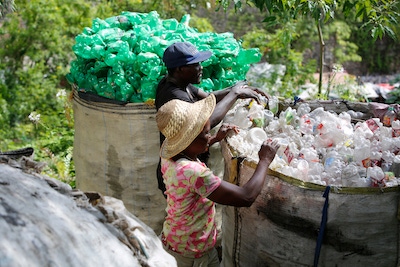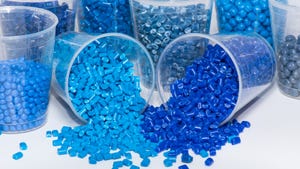Compound made by Lavergne from ocean bound plastic waste employs Clariant’s Exolit OP halogen-free flame retardant and achieves UL 94 V-0 rating; targeted to electric and electronic applications such as laptop parts; mechanical properties fully in line with OEM requirements.
March 2, 2020

Clariant has teamed up with Lavergne, a leader in the production of sustainable engineering resin from recycled plastic, to develop halogen-free flame-retardant polyester compounds made from ocean-bound plastics. With the first grade already commercialized, the advance is supporting demand from major electrical and electronics brand owners for flame-retarded post-consumer recyclate grades for equipment parts.
|
Laptop computers are a typical end application for Lavergne’s VYPET OBP compounds using Clariant’s Exolit OP flame retardants. (Photo: Clariant) |
|
Collection of PET bottles for recycling in Port-au-Prince, Haiti. (Photo: Courtesy of HP) |
Lavergne’s close collaboration with Clariant to develop halogen-free flame-retardant versions of its recycled polyester grades, arises from the company’s wider mission to create new uses for plastic, in this case polyethylene terephthalate (PET), recycled from ocean-bound waste streams. Ocean-bound plastic (OBP) refers to plastic waste that is recovered from the over 8 million tonnes of plastic currently entering the oceans each year.
The first new flame-retardant compound Lavergne VYPET OBP-FR has 30% glass fiber reinforcement and UL 94 V-0 flame rating at 0.8 mm thickness, which makes it suitable for many electric and electronic (E&E) plastic applications including aesthetic and structural parts. This recyclable OBP-based compound has already successfully passed molding trials at part manufacturers and is commercially available.
Clariant’s halogen-free Exolit OP flame retardants, were chosen for their environmental and health profile, as documented by the Clariant EcoTain label and a GreenScreen Benchmark 3 assessment for the key phosphinate ingredient. Adding to the circularity of the innovation, Exolit OP grades have been confirmed as suitable for various recycling processes without losing their flame retardant properties. Furthermore, as a contribution to less fossil resource consumption, Clariant announced in October 2019 that selected Exolit OP grades will also become available as Terra types , based on renewable carbon sources.
Intensive liaison and development work was required by Lavergne’s and Clariant’s experts to develop the right flame retardant and synergist formulation for this particular resin grade and also optimize the processing conditions of the compound. In fact, mechanical properties of OBP recyclates pose specific challenges because the repeated thermal treatment of polymers tends to progressively degrade the material. Because of the original compound’s success, the solution has now been extended to more than a dozen product lines, with each program undergoing additional testing prior to commercialization.
The joint project took more than a year to come to fruition, and both parties are eager to continue their working relationship. “Lavergne is the right place for plastics, not the oceans. We clean the oceans of plastics and turn the plastic wastes into high-end products. I am proud to be a part of Lavergne Green Innovation Team,” comments Davood Bagheri, Polymer Scientist at Lavergne.
This project to develop flame-retardant recyclate grades ties up with the support of major electronics brand owners (OEMs) and their demand for post-consumer recyclates. The use of recyclates is part of sustainability claims by OEMs and is rewarded in ecolabel schemes like the American EPEAT and German Blue Angel. OEMs are also supporting the sourcing of OBP by sponsoring collection and clean-up of waste. Whereas the applications targeted originally were less demanding components like packaging trays, the end uses for recyclates are now spreading to other structural parts of electronics equipment.
About the Author(s)
You May Also Like






